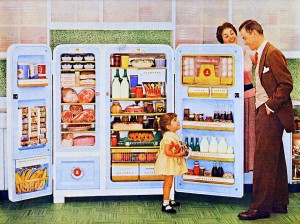 I have a secret. No, I’m not a super hero at night and I didn’t travel with the circus in my 20s, although both of those would be pretty cool. It’s far more shocking and I am going to share it with all of you. By day I’m an energy efficiency consultant who works to identify solutions for reducing energy use in homes and businesses and to convince people to make a change. By night, I have an old, inefficient refrigerator in my basement, which is being used to…..hold beer. To be fair, we also use it for product overflow and the occasional party storage. Still…
I have a secret. No, I’m not a super hero at night and I didn’t travel with the circus in my 20s, although both of those would be pretty cool. It’s far more shocking and I am going to share it with all of you. By day I’m an energy efficiency consultant who works to identify solutions for reducing energy use in homes and businesses and to convince people to make a change. By night, I have an old, inefficient refrigerator in my basement, which is being used to…..hold beer. To be fair, we also use it for product overflow and the occasional party storage. Still…
First, I wanted to know how much energy this monster in the basement was costing us. I knew the savings from a new model would be significant given the basement refrigerator was 20 years old but just how much would I save with a switch out? So I bought a Kill-o-Watt meter and went to work collecting data and number crunching. Here are the results:
1,458 kWh/year, which equates to about $160 annually on our utility bill (using $.11/kWh)
To compare, I found a similar sized ENERGY STAR certified refrigerator rated at 386 kWh/year, which costs just $42/year to run. That’s an energy savings of more than 70%! And let’s face it, the basement refrigerator’s days are numbered and warm beer is not an option.
I’m Convinced – Now What? When shopping for a new refrigerator or freezer, look for the yellow Energy Guide label, which provides annual energy consumption for each model. Many retailers provide this information online. If you are like me, I am always looking for the most efficient options – visit the ENERGY STAR website at www.energystar.gov, which also provides search and compare features.
Safe Refrigerator Disposal. Not only can you feel good about your smart purchase, but you can also ensure that your old refrigerator is properly recycled. Older refrigerators contain ozone-depleting refrigerants and/or foam blowing agents, depending on the year they were manufactured. These substances are also greenhouse gases, which contribute to climate change when emitted into the Earth’s atmosphere. According to the U.S. EPA:
- The average refrigerator aged 10+ years contains more than 120 pounds of recyclable steel.
- Recycling a 20-year old refrigerator saves 10,000 pounds of greenhouse gas emissions.
Several retailers offer take back programs, where they will recycle the old refrigerator for you. Partners participating in the U.S. EPA’s Responsible Appliance Disposal (RAD) Program work to recover ozone-depleting chemicals from old refrigerators as well as freezers, window air conditioners, and dehumidifiers. (more info: www2.epa.gov/rad)
Retailers in the Charlottesville area that partner with the RAD program include Best Buy, Sears, and The Home Depot. These retailers provide the haul away and recycling service for free when you purchase a new appliance. Looking to just get rid of an older appliance – they provide the service for a small fee.
Interested in doing some of your own home appliance monitoring? Check out the Kill-O-Watt meter and take your energy future into your own hands!
Betty’s energy efficient correspondent Rebecca Duff
{ Comments on this entry are closed }




